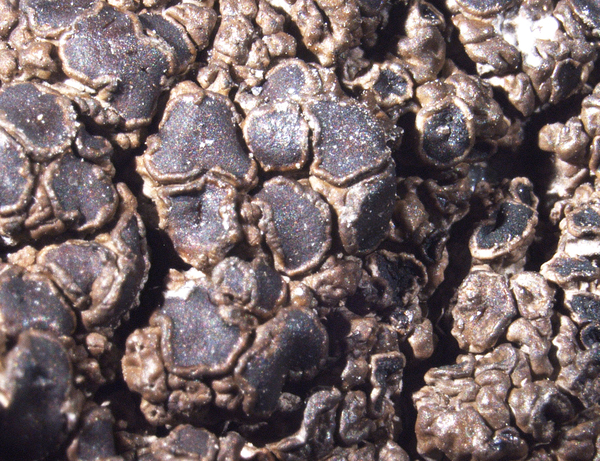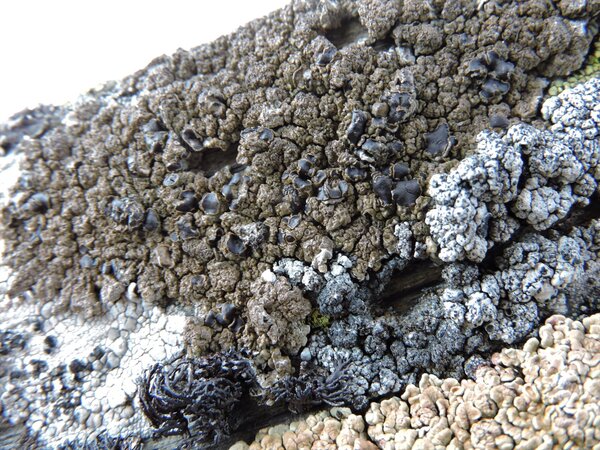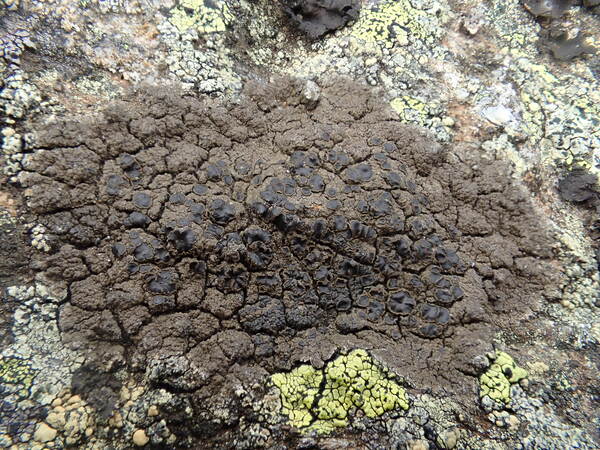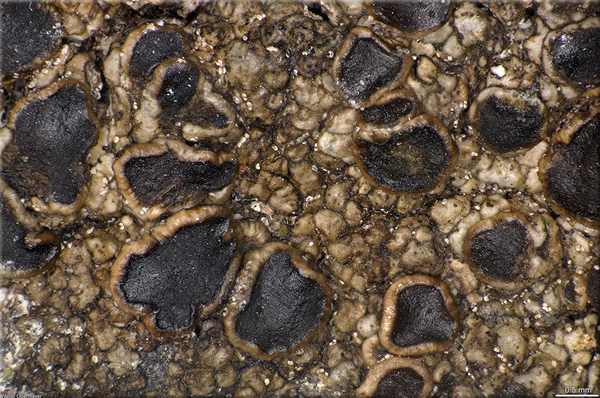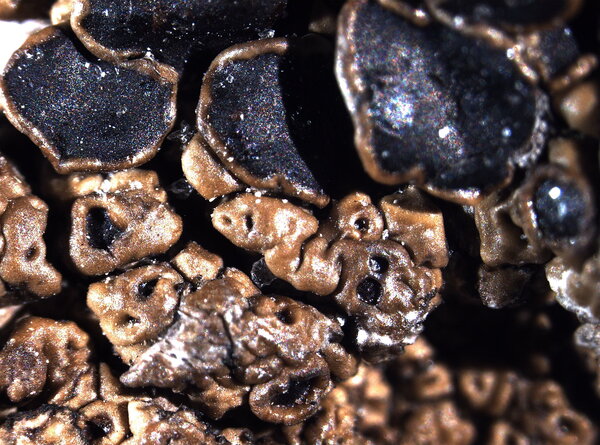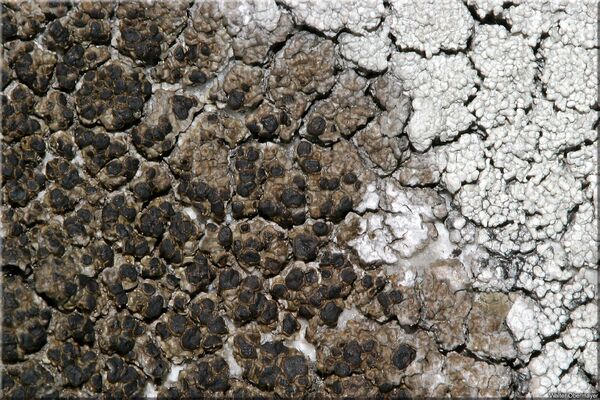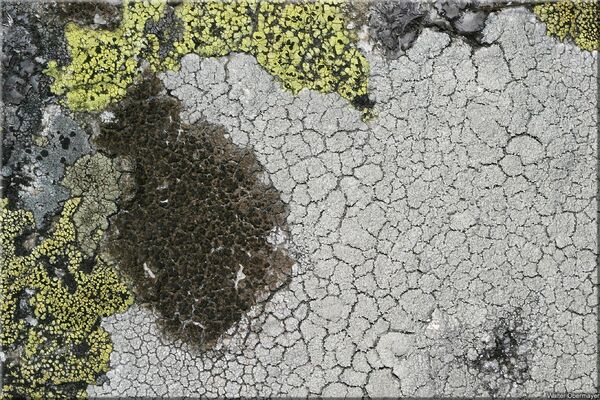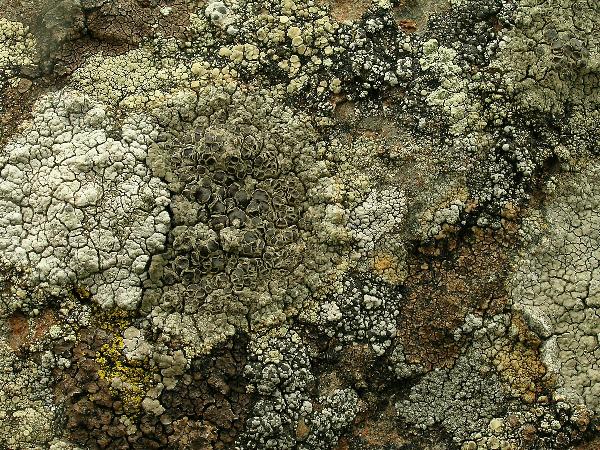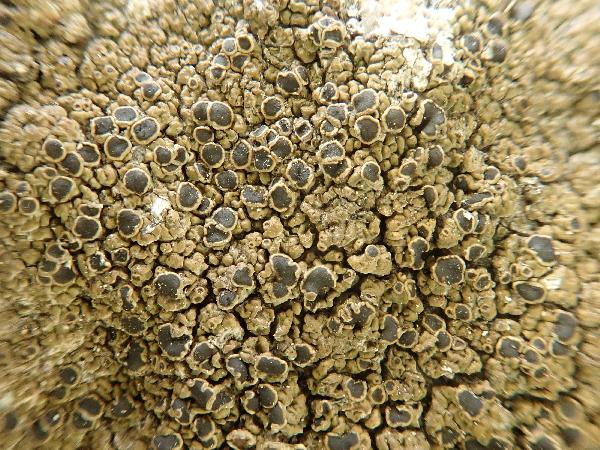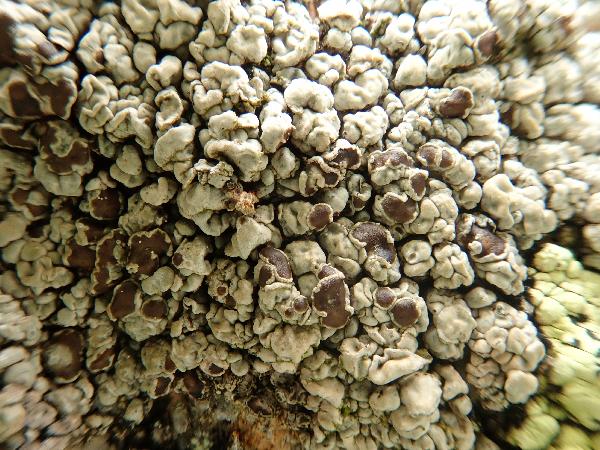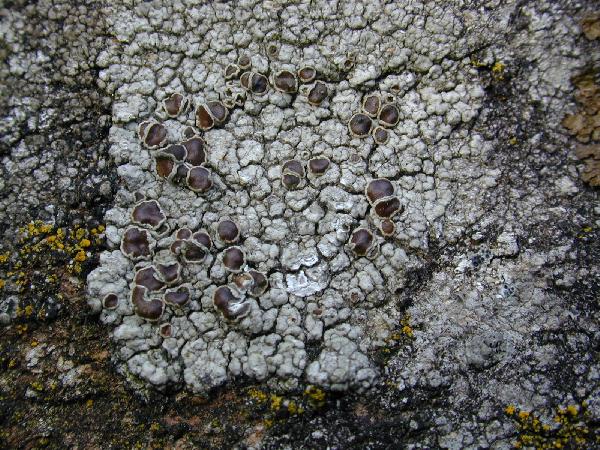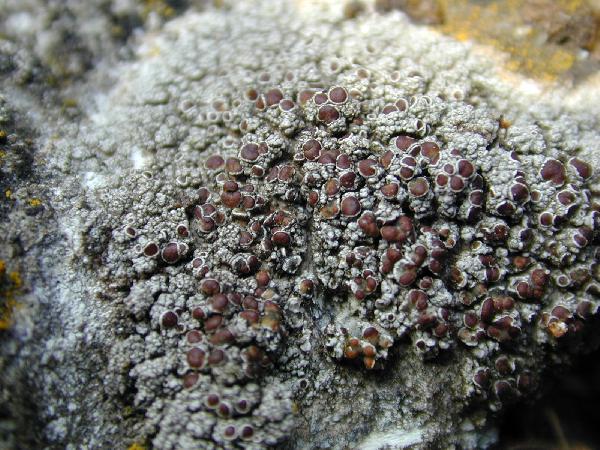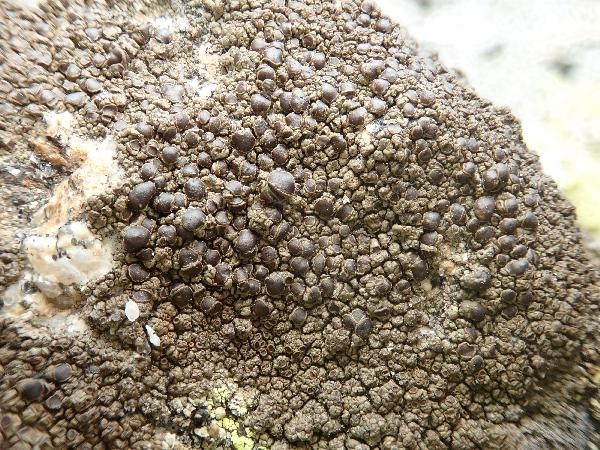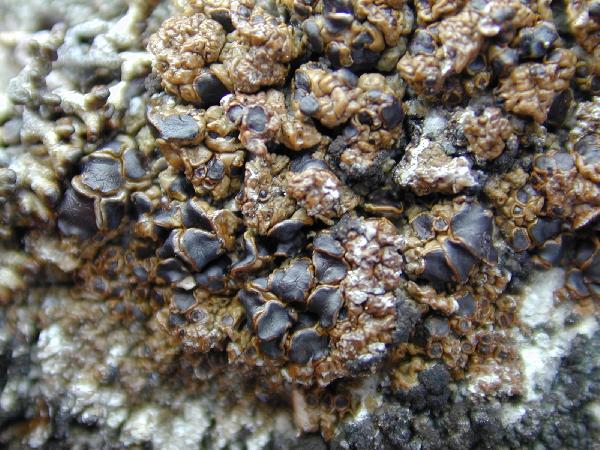Protoparmelia badia (Hoffm.) Hafellner var. badia
Beih. Nova Hedwigia, 79: 292, 1984. Basionym: Verrucaria badia Hoffm. - Deutschl. Fl., 2: 182, 1796.
Synonyms: Lecanora badia (Hoffm.) Ach.; Lecanora badia f. pallescens Harm.; Lecanora badia var. milvina Rabenh.; Lecanora badia var. picea (Dicks.) Link; Lecanora badia var. striatula Lamy; Lecanora grandis H. Magn.; Lecanora picea (Dicks.) Nyl. non auct.; Lichen piceus Dicks. non auct.; Protoparmelia badia (Hoffm.) Hafellner; Protoparmelia picea (Dicks.) Hafellner non auct.
Distribution: N - Frl (Tretiach & Hafellner 2000), Ven (Ravera & al. 2020b), TAA (Caniglia & al. 2002, Nascimbene 2008b, Lang 2009, Nascimbene & al. 2022), Lomb (Dalle Vedove & al. 2004), Piem (Isocrono & Falletti 1999, Isocrono & al. 2003, 2004, 2006, Isocrono & Piervittori 2008, Favero-Longo & al. 2015), VA (Piervittori & Isocrono 1999, Valcuvia 2000, Piervittori & al. 2004, Isocrono & al. 2008, Favero-Longo & Piervittori 2009, Matteucci & al. 2015c), Emil (Tretiach & al. 2008, Watson 2014, Fariselli & al. 2020), Lig (Brunialti & al. 1999). C - Tosc, Laz, Abr (Nimis & Tretiach 1999), Sar (Nöske 2000, Singh & al. 2015, Neuwirth 2018). S - Camp (Ricciardi & al. 2000), Bas (Ravera & al. 2017), Cal (Puntillo 1996), Si (Grillo 1998, Grillo & Caniglia 2004, Iacolino & Ottonello 2006, Brackel 2008b, Brackel & Puntillo 2023).
Description: Thallus crustose, episubstratic, rimose-areolate to warted, up to 1.5-2.5 mm thick, olivaceous brown, grey-brown or dark brown, often forming up to 10 cm wide patches, rarely delimited by a thin, black prothallus. Areoles mostly contiguous, irregular in shape, 0.6-1.5(-3) mm across, usually convex, epruinose, more or less glossy. Cortex 20-30 µm thick, with a brown upper layer overlain by a thin epinecral layer; medulla white or pale yellowish, I-. Apothecia lecanorine, at first immersed to adnate, later sessile, round or weakly angular by mutual compression, (0.4-)1-1.5(-2.5) mm across, with a chestnut brown to brown-black, slightly concave to convex, glossy and epruinose disc, and a usually paler, thick, entire to crenulate, persistent thalline margin. Thalline exciple corticate, c. 45 µm wide, with fine granules soluble in K; proper exciple poorly delimited, brown in outer part, colourless within, forming a 40-100 µm thick cupular layer below the hypothecium; epithecium olive-brown to yellowish brown, without granules, 10-20 µm thick; hymenium colourless, 50-70(-80) µm high, I+ blue; paraphyses coherent, branched in upper part, rarely anastomosing, 3-4 µm thick at mid-level, the apical cells 4-6 µm wide, with pale brown walls and a dark brown cap; hypothecium colourless or pale yellow. Asci 8-spored, clavate, approaching the Lecanora-type, with or without an ocular chamber, but always with a distinct, non-amyloid apical cushion. Ascospores 1-celled, hyaline, fusiform with pointed apices, (8-)10-13(-16) x (3-)4-6(-7) µm, the wall to 0.3 µm thick. Pycnidia immersed, black around the ostiole. Conidia straight, acicular, 6-9(-11) µm long. Photobiont chlorococcoid. Spot tests (better visible on microscopic sections): medulla K- or K+ pale yellow, C-, KC- or rarely KC+ fleeting pink to red-violet, P-, usually UV+ white. Chemistry: lobaric acid (major), zeorin, and unknown substances (minor, traces or absent).Note: on siliceous rocks, with a wide altitudinal range, reaching the nival belt of the Alps; most common above treeline in the Alps, but sometimes extending to lower altitudes, albeit rarely to the Mediterranean belt (e.g. in Sardinia). The species, in its present circumscription, is heterogeneous (Singh & al. 2015).
Growth form: Crustose
Substrata: rocks
Photobiont: green algae other than Trentepohlia
Reproductive strategy: mainly sexual
Commonnes-rarity: (info)
Alpine belt: common
Subalpine belt: very common
Oromediterranean belt: rather rare
Montane belt: rare
Submediterranean belt: extremely rare
Padanian area: absent
Humid submediterranean belt: very rare
Humid mediterranean belt: extremely rare
Dry mediterranean belt: absent
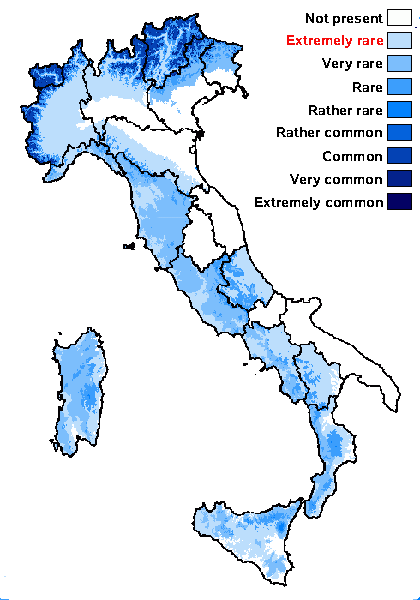
Predictive model
Herbarium samples
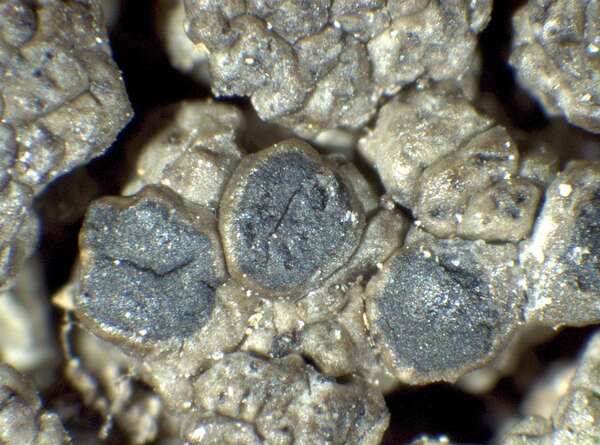

P.L. Nimis; Owner: Department of Life Sciences, University of Trieste
Herbarium: TSB (35363)
2002/07/18
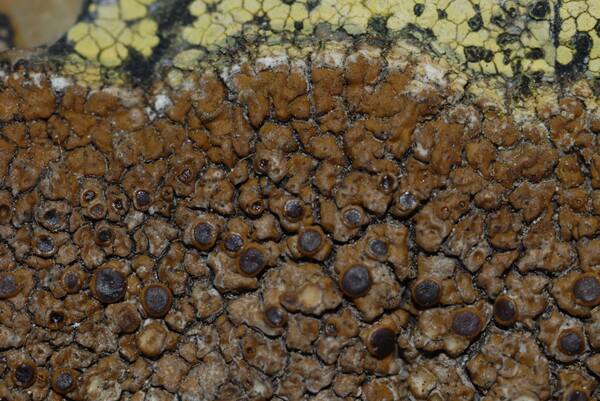

Domenico Puntillo; Owner: Department of Life Sciences, University of Trieste
Italy, Basilicata, Potenza, Potenza. Calvello, Cerro Falcone, on acid rocks
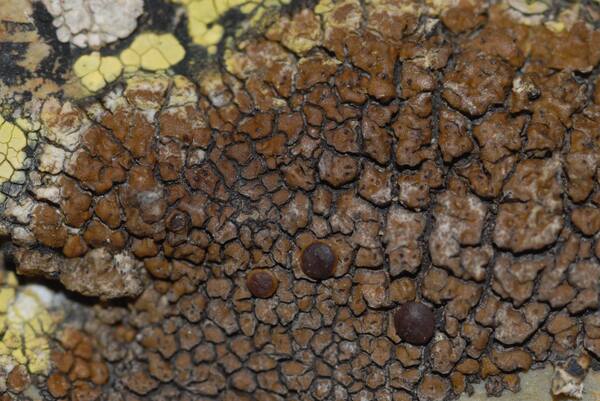

Domenico Puntillo; Owner: Department of Life Sciences, University of Trieste
Italy, Basilicata, Potenza, Potenza. Calvello, Cerro Falcone, on acid rocks

Courtesy Danièle et Olivier Gonnet - Source: https://www.afl-lichenologie.fr/Photos_AFL/Photos_AFL_P/Protoparmelia_badia.htm
France, sur rocher siliceux - session AFL 2005 - Lozère
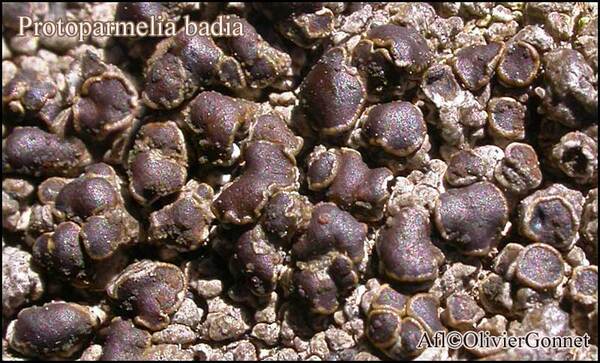
Courtesy Danièle et Olivier Gonnet - Source: https://www.afl-lichenologie.fr/Photos_AFL/Photos_AFL_P/Protoparmelia_badia.htm
France, sur rocher siliceux - session AFL 2005 - Lozère
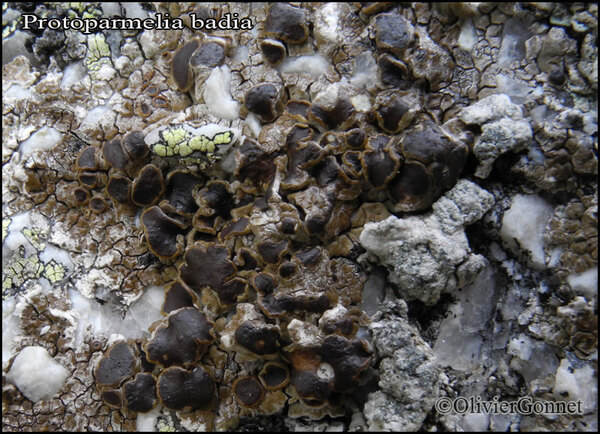
Courtesy Danièle et Olivier Gonnet - Source: https://www.afl-lichenologie.fr/Photos_AFL/Photos_AFL_P/Protoparmelia_badia.htm
France, 21/10/2012 - Apozzines du Coscione, alt. 1600 m - Corse

Courtesy Danièle et Olivier Gonnet - Source: https://www.afl-lichenologie.fr/Photos_AFL/Photos_AFL_P/Protoparmelia_badia.htm
France, 21/10/2012 - Apozzines du Coscione, alt. 1600 m - Corse
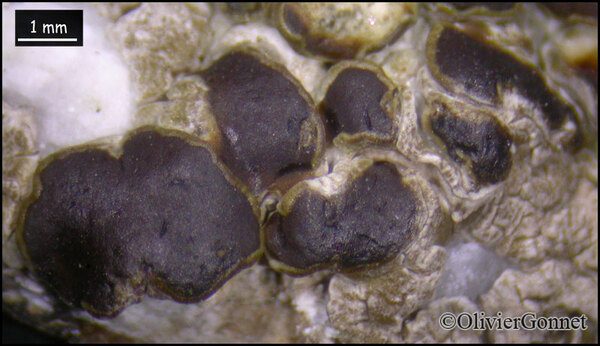
Courtesy Danièle et Olivier Gonnet - Source: https://www.afl-lichenologie.fr/Photos_AFL/Photos_AFL_P/Protoparmelia_badia.htm
France, 2/9/2014 - Bonneval-sur-Arc, Pont de L'Oulietta, alt. 2500 m - Savoie
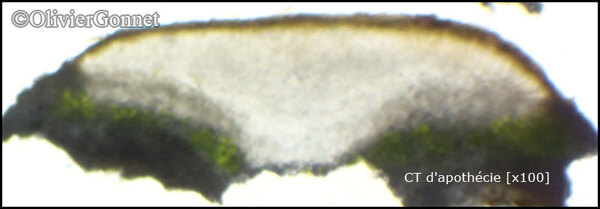
Courtesy Danièle et Olivier Gonnet - Source: https://www.afl-lichenologie.fr/Photos_AFL/Photos_AFL_P/Protoparmelia_badia.htm
France, 2/9/2014 - Bonneval-sur-Arc, Pont de L'Oulietta, alt. 2500 m - Savoie
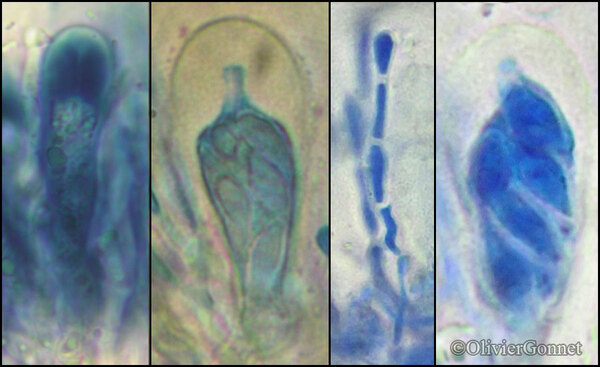
Courtesy Danièle et Olivier Gonnet - Source: https://www.afl-lichenologie.fr/Photos_AFL/Photos_AFL_P/Protoparmelia_badia.htm
France, 2/9/2014 - Bonneval-sur-Arc, Pont de L'Oulietta, alt. 2500 m - Savoie
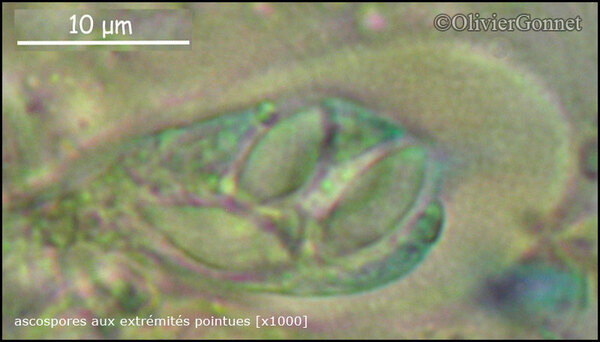
Courtesy Danièle et Olivier Gonnet - Source: https://www.afl-lichenologie.fr/Photos_AFL/Photos_AFL_P/Protoparmelia_badia.htm
France, 2/9/2014 - Bonneval-sur-Arc, Pont de L'Oulietta, alt. 2500 m - Savoie
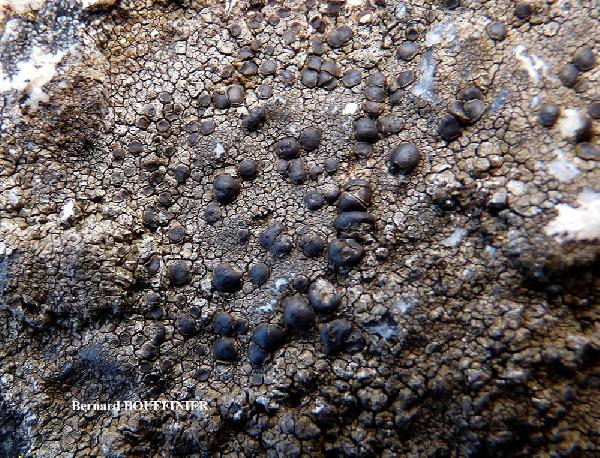
Bernard Bouffinier - Source: http://www.lichensmaritimes.org/index.php?task=fiche&lichen=236&lang=en
Italy, Sardinia
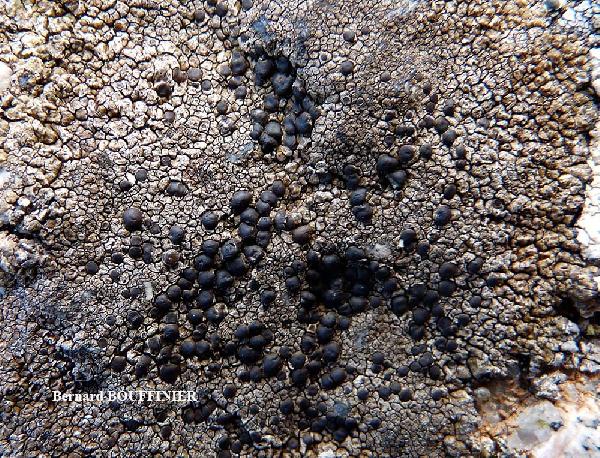
Bernard Bouffinier - Source: http://www.lichensmaritimes.org/index.php?task=fiche&lichen=236&lang=en
Italy, Sardinia
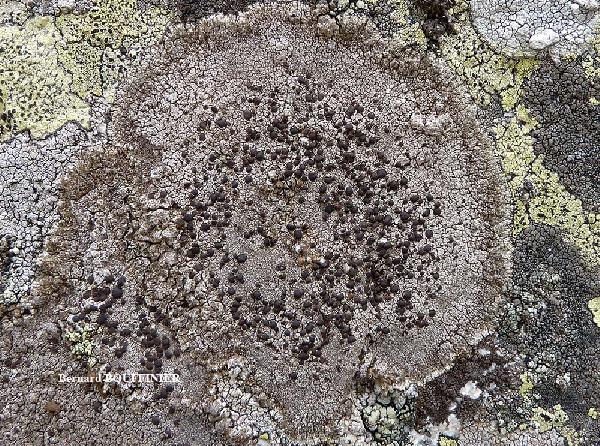
Bernard Bouffinier - Source: http://www.lichensmaritimes.org/index.php?task=fiche&lichen=236&lang=en
Italy, Sardinia
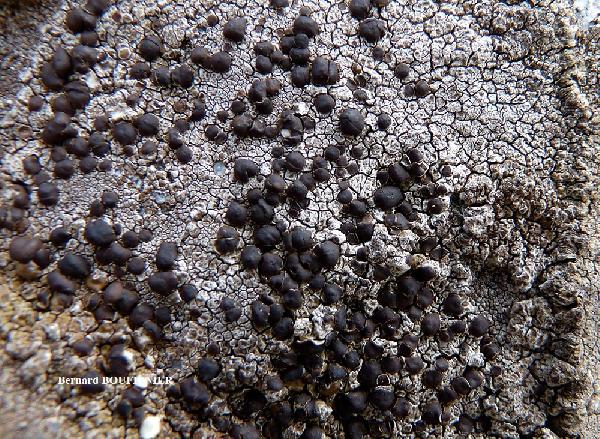
Bernard Bouffinier - Source: http://www.lichensmaritimes.org/index.php?task=fiche&lichen=236&lang=en
Italy, Sardinia
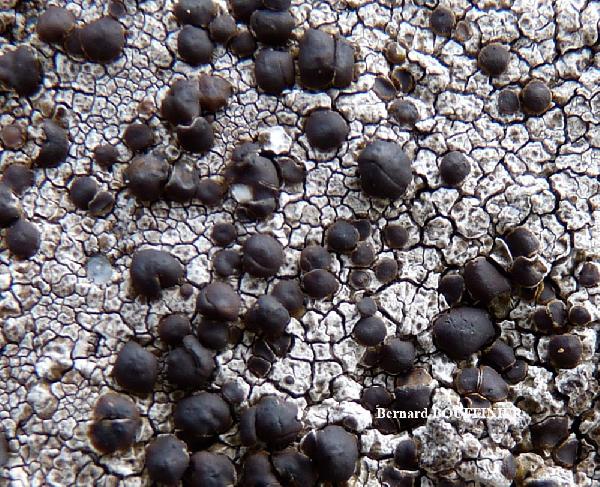
Bernard Bouffinier - Source: http://www.lichensmaritimes.org/index.php?task=fiche&lichen=236&lang=en
Italy, Sardinia
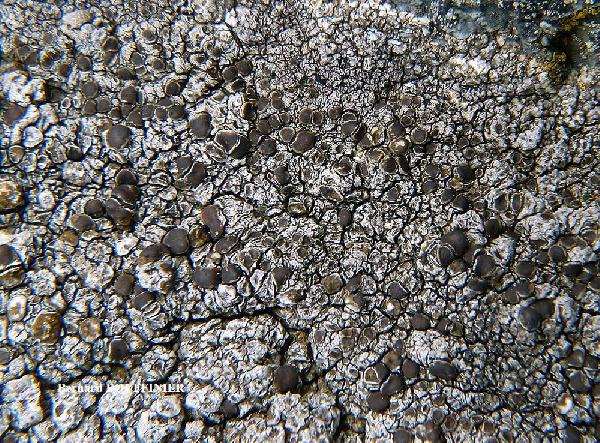
Bernard Bouffinier - Source: http://www.lichensmaritimes.org/index.php?task=fiche&lichen=236&lang=en
France, Trefeuntec
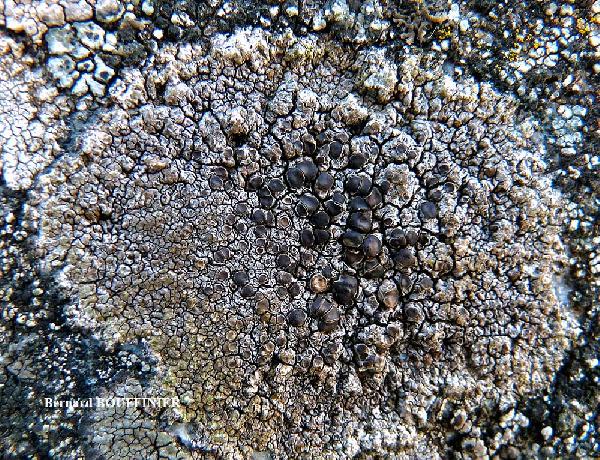
Bernard Bouffinier - Source: http://www.lichensmaritimes.org/index.php?task=fiche&lichen=236&lang=en
France, Camaret
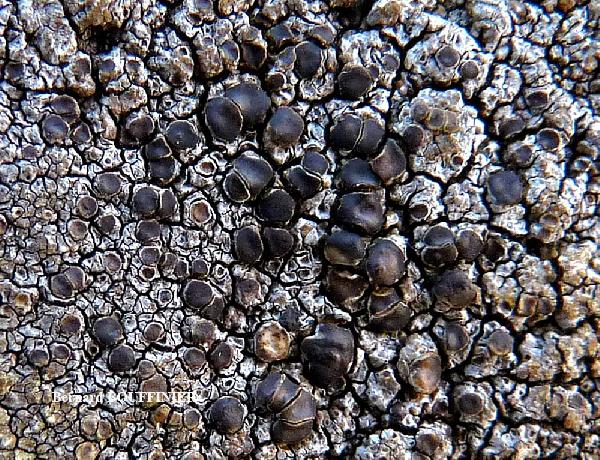
Bernard Bouffinier - Source: http://www.lichensmaritimes.org/index.php?task=fiche&lichen=236&lang=en
France, Camaret
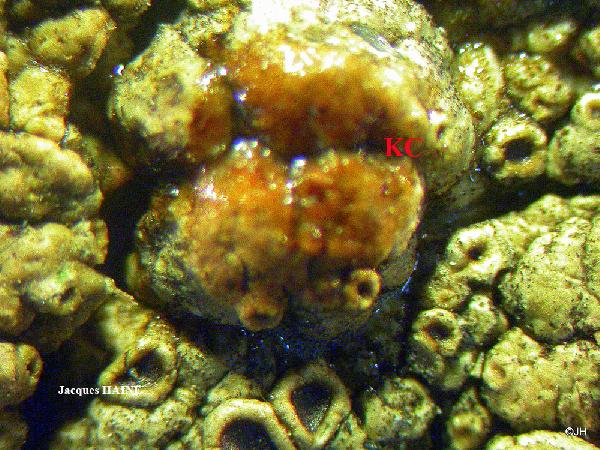
Jacques Haine - Source: http://www.lichensmaritimes.org/index.php?task=fiche&lichen=236&lang=en
France, Savoy, Maurienne
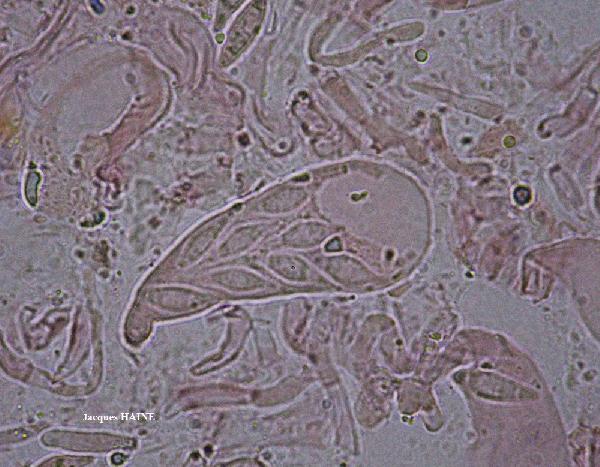
Jacques Haine - Source: http://www.lichensmaritimes.org/index.php?task=fiche&lichen=236&lang=en
France, Savoy, Maurienne
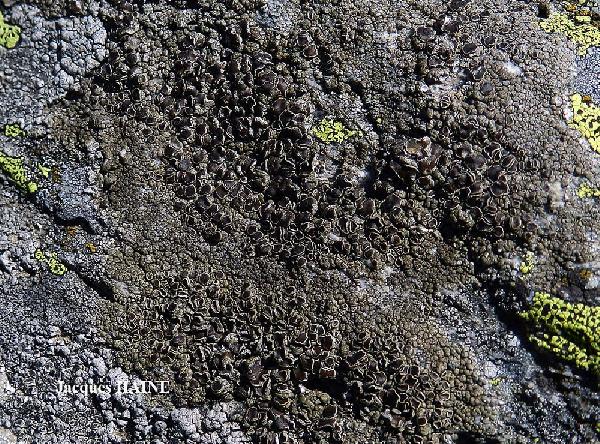
Jacques Haine - Source: http://www.lichensmaritimes.org/index.php?task=fiche&lichen=236&lang=en
France, Savoy, Maurienne
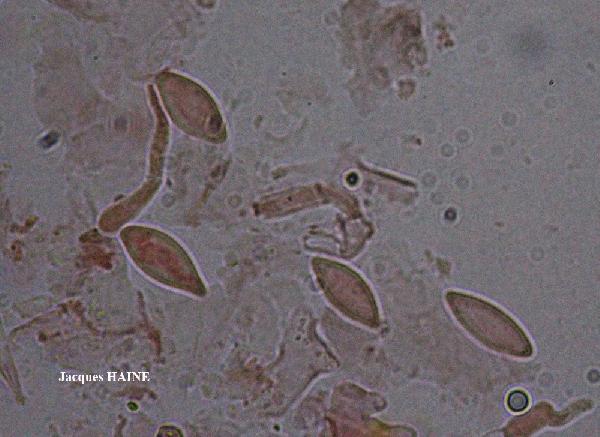
Jacques Haine - Source: http://www.lichensmaritimes.org/index.php?task=fiche&lichen=236&lang=en
France, Savoy, Maurienne
Growth form: Crustose
Substrata: rocks
Photobiont: green algae other than Trentepohlia
Reproductive strategy: mainly sexual
Commonnes-rarity: (info)
Alpine belt: common
Subalpine belt: very common
Oromediterranean belt: rather rare
Montane belt: rare
Submediterranean belt: extremely rare
Padanian area: absent
Humid submediterranean belt: very rare
Humid mediterranean belt: extremely rare
Dry mediterranean belt: absent

Predictive model
| Herbarium samples |


P.L. Nimis; Owner: Department of Life Sciences, University of Trieste
Herbarium: TSB (35363)
2002/07/18


Domenico Puntillo; Owner: Department of Life Sciences, University of Trieste
Italy, Basilicata, Potenza, Potenza. Calvello, Cerro Falcone, on acid rocks


Domenico Puntillo; Owner: Department of Life Sciences, University of Trieste
Italy, Basilicata, Potenza, Potenza. Calvello, Cerro Falcone, on acid rocks

Courtesy Danièle et Olivier Gonnet - Source: https://www.afl-lichenologie.fr/Photos_AFL/Photos_AFL_P/Protoparmelia_badia.htm
France, sur rocher siliceux - session AFL 2005 - Lozère

Courtesy Danièle et Olivier Gonnet - Source: https://www.afl-lichenologie.fr/Photos_AFL/Photos_AFL_P/Protoparmelia_badia.htm
France, sur rocher siliceux - session AFL 2005 - Lozère

Courtesy Danièle et Olivier Gonnet - Source: https://www.afl-lichenologie.fr/Photos_AFL/Photos_AFL_P/Protoparmelia_badia.htm
France, 21/10/2012 - Apozzines du Coscione, alt. 1600 m - Corse

Courtesy Danièle et Olivier Gonnet - Source: https://www.afl-lichenologie.fr/Photos_AFL/Photos_AFL_P/Protoparmelia_badia.htm
France, 21/10/2012 - Apozzines du Coscione, alt. 1600 m - Corse

Courtesy Danièle et Olivier Gonnet - Source: https://www.afl-lichenologie.fr/Photos_AFL/Photos_AFL_P/Protoparmelia_badia.htm
France, 2/9/2014 - Bonneval-sur-Arc, Pont de L'Oulietta, alt. 2500 m - Savoie

Courtesy Danièle et Olivier Gonnet - Source: https://www.afl-lichenologie.fr/Photos_AFL/Photos_AFL_P/Protoparmelia_badia.htm
France, 2/9/2014 - Bonneval-sur-Arc, Pont de L'Oulietta, alt. 2500 m - Savoie

Courtesy Danièle et Olivier Gonnet - Source: https://www.afl-lichenologie.fr/Photos_AFL/Photos_AFL_P/Protoparmelia_badia.htm
France, 2/9/2014 - Bonneval-sur-Arc, Pont de L'Oulietta, alt. 2500 m - Savoie

Courtesy Danièle et Olivier Gonnet - Source: https://www.afl-lichenologie.fr/Photos_AFL/Photos_AFL_P/Protoparmelia_badia.htm
France, 2/9/2014 - Bonneval-sur-Arc, Pont de L'Oulietta, alt. 2500 m - Savoie

Bernard Bouffinier - Source: http://www.lichensmaritimes.org/index.php?task=fiche&lichen=236&lang=en
Italy, Sardinia

Bernard Bouffinier - Source: http://www.lichensmaritimes.org/index.php?task=fiche&lichen=236&lang=en
Italy, Sardinia

Bernard Bouffinier - Source: http://www.lichensmaritimes.org/index.php?task=fiche&lichen=236&lang=en
Italy, Sardinia

Bernard Bouffinier - Source: http://www.lichensmaritimes.org/index.php?task=fiche&lichen=236&lang=en
Italy, Sardinia

Bernard Bouffinier - Source: http://www.lichensmaritimes.org/index.php?task=fiche&lichen=236&lang=en
Italy, Sardinia

Bernard Bouffinier - Source: http://www.lichensmaritimes.org/index.php?task=fiche&lichen=236&lang=en
France, Trefeuntec

Bernard Bouffinier - Source: http://www.lichensmaritimes.org/index.php?task=fiche&lichen=236&lang=en
France, Camaret

Bernard Bouffinier - Source: http://www.lichensmaritimes.org/index.php?task=fiche&lichen=236&lang=en
France, Camaret

Jacques Haine - Source: http://www.lichensmaritimes.org/index.php?task=fiche&lichen=236&lang=en
France, Savoy, Maurienne

Jacques Haine - Source: http://www.lichensmaritimes.org/index.php?task=fiche&lichen=236&lang=en
France, Savoy, Maurienne

Jacques Haine - Source: http://www.lichensmaritimes.org/index.php?task=fiche&lichen=236&lang=en
France, Savoy, Maurienne

 INDEX FUNGORUM
INDEX FUNGORUM
 GBIF
GBIF
 DOLICHENS
DOLICHENS
